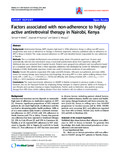Population Studies and Research Institute: Recent submissions
Now showing items 41-60 of 64
-
Factors associated with non-adherence with highly active antiretroviral therapy in Nairobi, Kenya
(2011)Antiretroviral therapy (ART) requires high-level (> 95%) adherence. Kenya is rolling out ART access programmes and, issue of adherence to therapy is therefore imperative. However, published data on adherence to ART in ... -
Comparing maternal health indicators between teenagers and older women in sub-Saharan Africa
(Department of Population Studies and Research Institute, University of Nairobi, 2004) -
The Effect of Economic Crisis on Youth Precariousness in Nairobi: An Analysis of Itinerary to Adulthood of Three
(Department of Population Studies and Research Institute, University of Nairobi, 2004) -
Contraceptive use dynamics in Kenya: analysis of method choice and discontinuation. in a closer look at KDHS 2003: Further Analysis of Contraceptive Prevalence and Fertility Stalls–Summaries of Selected NCAPD Working Papers. Pp 16-18.www.ncapd-ke.org/publications MEASURE Evaluation Publication paper Number tr-06-40-en
(Department of Philosophy and Religious Studies, University of Nairobi, Kenya, 2003) -
The link between HIV/AIDS and recent fertility patterns in Kenya
(Department of Population Studies and Research Institute, University of Nairobi, 2007) -
Assessment of Family Planning Services in Kenya: Evidence from the 2004 Kenya Service Provision Assessment Survey
(Calverton, Maryland, USA: Macro International Inc.Department of Population Studies and Research Institute, University of Nairobi, 2009) -
Patterns of female first marriage in Sub Saharan Africa
(Department of Population Studies and Research Institute, University of Nairobi, 2012)Paper submitted to Dounia. revue d'intelligence stratégique et des relations internationals www.dounia-risri.net under the Theme: Population and development challenges in sub-Saharan Africa -
Trends in intra regional migration in Kenya
(Department of Population Studies and Research Institute, University of Nairobi, 2012)Working Paper submitted to United Nations Statistical Division. UNSD on Regional project on “Strengthening National Capacity to Analyze, Present and Disseminate Census Data for Evidence-based Policy Making -
Contraceptive use dynamics in Kenya: analysis of method choice and discontinuation
(Department of Population Studies and Research Institute, University of Nairobi, 2007)This study aimed at identifying correlates of contraceptive method choice and also the experiences and behaviour of women who have used contraception.This was to enable the understanding of the overall effectiveness of ... -
Urban integration in Africa: a socio-demographic survey of greater Nairobi.
(Department of Population Studies and Research Institute, University of Nairobi, 2004)The main purpose of this study was to measure the medium and long-term effects of macro-economic changes on access to job market, access to housing and demographic behaviour. It was also intended to provide policy makers ... -
Adolescent safe motherhood survey (ASMS) of 2002
(Department of Population Studies and Research Institute, University of Nairobi, 2006)The survey was carried out by the African Population and Health Research Center, in collaboration with the Opportunities and Choices Reproductive Health Research Programme of the University of Southampton, and the Population ... -
Assessment of the link between HIV/AIDS and recent fertility patterns in Kenya
(Department of Population Studies and Research Institute, University of Nairobi, 2007)The study focused on both individual and contextual community HIV/AIDS factors and role of the proximate fertility determinants. The main objectives of the study was to examine regional variations in the link between ... -
Influencing policy and financing reforms to improve access to family planning for the poor in Kenya
(Department of Population Studies and Research Institute, University of Nairobi, 2009)he purpose of this study was to understand the issues behind low family planning access by the poor other than the policy and programmatic issues. The assessment was also expected to come out with strate gies that could ... -
Analysis age patterns of mortality in Kenya. Towards Model life table
(Department of Population Studies and Research Institute, University of Nairobi, 2013)This is an attempt to establish models life tables for Kenyan counties and act as a reference model life table for benchmarking and determination of changes in overall mortality rates in Kenya -
The demographic dividend: a gift or a curse. youth research compendium
(Nairobi: Institute of Economic AffairsDepartment of Population Studies and Research Institute, University of Nairobi, 2011)No associated abstract -
Knowledge, attitude and practices on jigger infestation among household members aged 18 to 60 years: case study of a rural location in Kenya
(school of population studies and research institute, 2012)Jigger flea, also known as sand flea, Chigoe or Tunga penetrans is an ecto-parasite which causes Tungiasis parasitic condition of humans and animals. The flea affects many impoverished populations living in sub- Saharan ... -
The Effect of Education on the Timing of Marriage in Kenya
(Population Studies and Research Institute, University of Nairobi, 2005)This paper investigates the effect of education on the timing of marriage among Kenyan women and the relative effects of education across generations of women. Data used is drawn from the 1998 Kenya Demographic and Health ... -
Comparing Maternal Health Indicators between Teenagers and Older Women in Sub-Saharan Africa: evidence from DHS
(Population Studies and Research Institute, University of Nairobi, Kenya, 2012)Most literature supports the notion that teenage childbearing is generally associated with higher risk of adverse maternal and newborn health outcomes. There is however continued debate on whether this association is ... -
Analysis of birth intervals in Kenya.
(Nairobi: University of NairobiDepartment of Population Studies and Research Institute, 2001)






